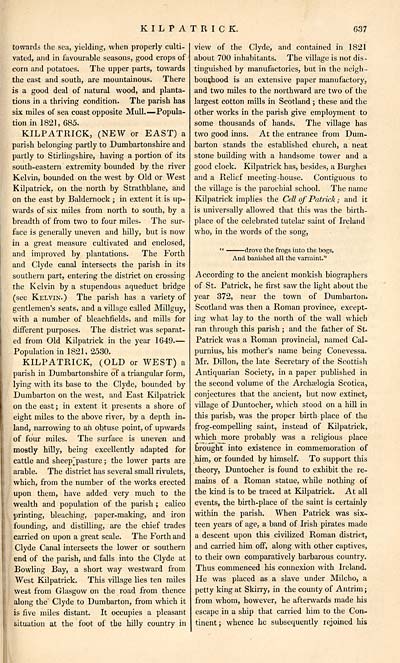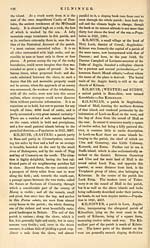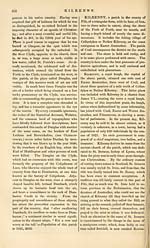Gazetteer of Scotland > Volume 2
(153) Page 637
Download files
Complete book:
Individual page:
Thumbnail gallery: Grid view | List view

KILPATRICK.
637
toivards the sea, yielding, when properly culti-
vated, and in favourable seasons, good crops of
corn and potatoes. The upper parts, towards
the east and south, are mountainous. There
is a good deal of natural wood, and planta-
tions in a thriving condition. The parish has
six miles of sea coast opposite Mull.— Popula-
tion in 1821,685.
KILPATRICK, (NEW or EAST) a
parish belonging partly to Dumbartonshire and
partly to Stirlingshire, having a portion of its
south-eastern extremity bounded by the river
Kelvin, bounded on the west by Old or West
Kilpatrick, on the north by Strathblane, and
on the east by Baldernock ; in extent it is up-
wards of six miles from north to south, by a
breadth of from two to four miles. The sur-
face is generally uneven and hilly, but is now
in a great measure cultivated and enclosed,
and improved by plantations. The Forth
and Clyde canal intersects the parish in its
southern part, entering the district on crossing
the Kelvin by a stupendous aqueduct bridge
(see Kelvin.) The parish has a variety of
gentlemen's seats, and a village called Millguy,
with a number of bleachfields, and mills for
different purposes. The district was separat-
ed from Old Kilpatrick in the year 1649 —
Population in 1821, 2530.
KILPATRICK, (OLD or WEST) a
parish in Dumbartonshire of a triangular form,
lying with its base to the Clyde, bounded by
Dumbarton on the west, and East Kilpatrick
on the east ; in extent it presents a shore of
eight miles to the above river, by a depth in-
land, narrowing to ah obtuse point, of upwards
of four miles. The surface is uneven and
mostly hilly, being excellently adapted for
cattle and sheep^pasture ; the lower parts are
arable. The district has several small rivulets,
which, from the number of the works erected
upon them, have added very much to the
wealth and population of the parish ; calico
printing, bleaching, paper-making, and iron
founding, and distilling, are the chief trades
carried on upon a great scale. The Forth and
Clyde Canal intersects the lower or southern
end of the parish, and falls into the Clyde at
Bowling Bay, a short way westward from
West Kilpatrick. This village lies ten miles
west from Glasgow on the road from thence
along the Clyde to Dumbarton, from which it
is five miles distant. It occupies a pleasant
situation at the foot of the hilly country in
view of the Clyde, and contained in 1821
about 700 inhabitants. The village is not dis-
tinguished by manufactories, but in the neigh-
bourhood is an extensive paper manufactory,
and two miles to the northward are two of the
largest cotton mills in Scotland ; these and the
other works in the parish give employment to
some thousands of hands. The village has
two good inns. At the entrance from Dum-
barton stands the established church, a neat
stone building with a handsome tower and a
good clock. Kilpatrick has, besides, a Burghei
and a Relief meeting-house. Contiguous to
the village is the parochial school. The name
Kilpatrick implies the Cell of Patrick ; and it
is universally allowed that this was the birth-
place of the celebrated tutelar saint of Ireland
who, in the words of the song,
" drove the frogs into the bogs,
And banished all the varmint."
According to the ancient monkish biographers
of St. Patrick, he first saw the light about the
year 372, near the town of Dumbarton.
Scotland was then a Roman province, except-
ing what lay to the north of the wall which
ran through this parish ; and the father of St-
Patrick was a Roman provincial, named Cal-
purnius, his mother's name being Conevessa.
Mr. Dillon, the late Secretary of the Scottish
Antiquarian Society, in a paper published in
the second volume of the Archaelogia Scotica,
conjectures that the ancient, but now extinct,
village of Duntocher, which stood on a hill in
this parish, was the proper birth place of the
frog-compelling saint, instead of Kilpatrick,
which more probably was a religious place
brought into existence in commemoration of
him, or founded by himself. To support this
theory, Duntocher is found to exhibit the re-
mains of a Roman statue, while nothing of
the kind is to be traced at Kilpatrick. At all
events, the birth-place of the saint is certainly
within the parish. When Patrick was six-
teen years of age, a band of Irish pirates made
a descent upon this civilized Roman district,
and carried him off, along with other captives,
to their own comparatively barbarous country.
Thus commenced his connexion with Ireland.
He was placed as a slave under Milcho, a
petty king at Skirry, in the county of Antrim ;
from whom, however, he afterwards made his
escape in a ship that carried him to the Con-
tinent; whence he subsequently rejoined his
637
toivards the sea, yielding, when properly culti-
vated, and in favourable seasons, good crops of
corn and potatoes. The upper parts, towards
the east and south, are mountainous. There
is a good deal of natural wood, and planta-
tions in a thriving condition. The parish has
six miles of sea coast opposite Mull.— Popula-
tion in 1821,685.
KILPATRICK, (NEW or EAST) a
parish belonging partly to Dumbartonshire and
partly to Stirlingshire, having a portion of its
south-eastern extremity bounded by the river
Kelvin, bounded on the west by Old or West
Kilpatrick, on the north by Strathblane, and
on the east by Baldernock ; in extent it is up-
wards of six miles from north to south, by a
breadth of from two to four miles. The sur-
face is generally uneven and hilly, but is now
in a great measure cultivated and enclosed,
and improved by plantations. The Forth
and Clyde canal intersects the parish in its
southern part, entering the district on crossing
the Kelvin by a stupendous aqueduct bridge
(see Kelvin.) The parish has a variety of
gentlemen's seats, and a village called Millguy,
with a number of bleachfields, and mills for
different purposes. The district was separat-
ed from Old Kilpatrick in the year 1649 —
Population in 1821, 2530.
KILPATRICK, (OLD or WEST) a
parish in Dumbartonshire of a triangular form,
lying with its base to the Clyde, bounded by
Dumbarton on the west, and East Kilpatrick
on the east ; in extent it presents a shore of
eight miles to the above river, by a depth in-
land, narrowing to ah obtuse point, of upwards
of four miles. The surface is uneven and
mostly hilly, being excellently adapted for
cattle and sheep^pasture ; the lower parts are
arable. The district has several small rivulets,
which, from the number of the works erected
upon them, have added very much to the
wealth and population of the parish ; calico
printing, bleaching, paper-making, and iron
founding, and distilling, are the chief trades
carried on upon a great scale. The Forth and
Clyde Canal intersects the lower or southern
end of the parish, and falls into the Clyde at
Bowling Bay, a short way westward from
West Kilpatrick. This village lies ten miles
west from Glasgow on the road from thence
along the Clyde to Dumbarton, from which it
is five miles distant. It occupies a pleasant
situation at the foot of the hilly country in
view of the Clyde, and contained in 1821
about 700 inhabitants. The village is not dis-
tinguished by manufactories, but in the neigh-
bourhood is an extensive paper manufactory,
and two miles to the northward are two of the
largest cotton mills in Scotland ; these and the
other works in the parish give employment to
some thousands of hands. The village has
two good inns. At the entrance from Dum-
barton stands the established church, a neat
stone building with a handsome tower and a
good clock. Kilpatrick has, besides, a Burghei
and a Relief meeting-house. Contiguous to
the village is the parochial school. The name
Kilpatrick implies the Cell of Patrick ; and it
is universally allowed that this was the birth-
place of the celebrated tutelar saint of Ireland
who, in the words of the song,
" drove the frogs into the bogs,
And banished all the varmint."
According to the ancient monkish biographers
of St. Patrick, he first saw the light about the
year 372, near the town of Dumbarton.
Scotland was then a Roman province, except-
ing what lay to the north of the wall which
ran through this parish ; and the father of St-
Patrick was a Roman provincial, named Cal-
purnius, his mother's name being Conevessa.
Mr. Dillon, the late Secretary of the Scottish
Antiquarian Society, in a paper published in
the second volume of the Archaelogia Scotica,
conjectures that the ancient, but now extinct,
village of Duntocher, which stood on a hill in
this parish, was the proper birth place of the
frog-compelling saint, instead of Kilpatrick,
which more probably was a religious place
brought into existence in commemoration of
him, or founded by himself. To support this
theory, Duntocher is found to exhibit the re-
mains of a Roman statue, while nothing of
the kind is to be traced at Kilpatrick. At all
events, the birth-place of the saint is certainly
within the parish. When Patrick was six-
teen years of age, a band of Irish pirates made
a descent upon this civilized Roman district,
and carried him off, along with other captives,
to their own comparatively barbarous country.
Thus commenced his connexion with Ireland.
He was placed as a slave under Milcho, a
petty king at Skirry, in the county of Antrim ;
from whom, however, he afterwards made his
escape in a ship that carried him to the Con-
tinent; whence he subsequently rejoined his
Set display mode to: Large image | Transcription
Images and transcriptions on this page, including medium image downloads, may be used under the Creative Commons Attribution 4.0 International Licence unless otherwise stated. ![]()
| Gazetteers of Scotland, 1803-1901 > Gazetteer of Scotland > Volume 2 > (153) Page 637 |
|---|
| Permanent URL | https://digital.nls.uk/97432658 |
|---|
| Description | Volume II: Glenbanchor to Zetland. |
|---|---|
| Attribution and copyright: |
|
| Description | By Robert Chambers and William Chambers. Glasgow: Blackie & Son, 1838. 2 volumes. |
|---|---|
| Shelfmark | NF.1461.g.7 |
| Additional NLS resources: | |

